纳米金属研究进展
利用纳米颗粒改善金属涂层耐蚀性能研究进展

利用纳米颗粒改善金属涂层耐蚀性能研究进展纳米颗粒材料具有独特的物理和化学特性,可以被广泛应用于各个领域。
在金属涂层的研究中,纳米颗粒材料被广泛应用于改善金属涂层的耐蚀性能。
本文将综述利用纳米颗粒改善金属涂层耐蚀性能的研究进展。
一、纳米颗粒对金属涂层耐蚀性能的影响1.1 纳米颗粒增强金属涂层的抗腐蚀能力纳米颗粒能够与金属基体形成均匀的分散体系,并在涂层表面形成更致密的保护膜。
这种保护膜可以阻止外界腐蚀介质的侵入,提高金属涂层的抗腐蚀性能。
研究表明,添加纳米颗粒可以显著提高金属涂层的耐腐蚀性能,延长金属涂层的使用寿命。
1.2 纳米颗粒提高金属涂层的耐磨性能纳米颗粒可以有效地填充金属涂层中的缺陷和孔隙,提高涂层的致密性和硬度。
同时,纳米颗粒的形成还可以提高金属涂层的耐磨性能,减少摩擦损失。
因此,添加纳米颗粒可以有效地改善金属涂层的耐磨性能,延长涂层的使用寿命。
1.3 纳米颗粒改善金属涂层的耐氧化性能纳米颗粒可以形成致密的氧化层,并提供额外的保护作用,减少氧化介质对金属涂层的侵蚀。
研究发现,添加纳米颗粒可以显著提高金属涂层的耐氧化性能,防止金属涂层因氧化而失效。
这对于金属涂层在高温、高氧化介质下的应用具有重要意义。
二、利用纳米颗粒改善金属涂层耐蚀性能的方法2.1 纳米颗粒的表面修饰为了提高纳米颗粒与金属基体之间的相容性,常常需要对纳米颗粒进行表面修饰。
表面修饰可以使纳米颗粒与金属基体形成更牢固的结合,提高涂层的耐蚀性能。
常用的表面修饰方法包括硅化、钝化、改性等。
2.2 纳米颗粒的复合应用为了进一步提高金属涂层的耐蚀性能,可以将不同类型的纳米颗粒进行复合应用。
例如,可以将具有不同功能的纳米颗粒相互结合,形成复合纳米颗粒,同时改善金属涂层的抗腐蚀性能、耐磨性能和耐氧化性能。
2.3 纳米颗粒的结构调控通过调控纳米颗粒的形状、尺寸和组分,可以进一步改善纳米颗粒对金属涂层耐蚀性能的影响。
研究表明,纳米颗粒的形态特征对金属涂层的性能有着重要影响。
纳米材料的研究进展与应用
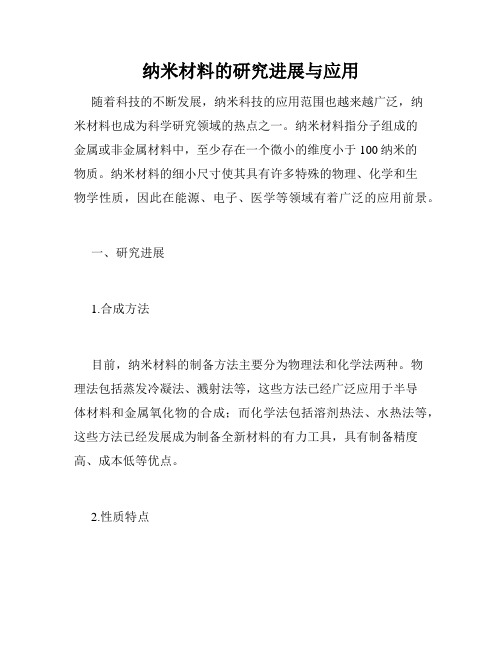
纳米材料的研究进展与应用随着科技的不断发展,纳米科技的应用范围也越来越广泛,纳米材料也成为科学研究领域的热点之一。
纳米材料指分子组成的金属或非金属材料中,至少存在一个微小的维度小于100纳米的物质。
纳米材料的细小尺寸使其具有许多特殊的物理、化学和生物学性质,因此在能源、电子、医学等领域有着广泛的应用前景。
一、研究进展1.合成方法目前,纳米材料的制备方法主要分为物理法和化学法两种。
物理法包括蒸发冷凝法、溅射法等,这些方法已经广泛应用于半导体材料和金属氧化物的合成;而化学法包括溶剂热法、水热法等,这些方法已经发展成为制备全新材料的有力工具,具有制备精度高、成本低等优点。
2.性质特点纳米材料的独特性质主要来源于其表面效应、量子效应和缺陷效应。
在表面效应方面,由于纳米材料的表面积较大,表面能就会比普通材料大,表面位错和表面尺寸效应对其性质的影响也将更加明显。
此外,纳米粒子的量子效应体现在其光学、电学等方面,例如量子点可以作为荧光探针等。
缺陷效应是纳米材料的另一个独特性质,在制备过程中容易产生氧化物等缺陷结构,这些结构能够影响其机械、热学等性质。
二、应用研究1.催化剂纳米材料是优异的催化剂,能够提高催化反应速率和选择性,提高催化效率,降低催化剂用量等。
例如,纳米金属催化剂可用于CO和H₂O反应生成CO₂和H₂,广泛应用于环保领域。
2.生物医学应用纳米材料在癌症治疗、药物输送、光疗、核磁共振成像、生物传感器等方面都有广泛的应用。
例如,纳米粒子通过改变表面功能化基团实现具有肿瘤特异性的分子靶向治疗,可较好地避免正常细胞的损伤。
3.能源储存在绿色能源和新能源研究中,纳米材料是很重要的研究方向。
例如,利用石墨烯、纳米碳管等纳米材料设计超级电容器、超级电池、锂离子电池等,可以提高能量密度和导电性能。
4.环保领域纳米材料还可应用于净水和废气处理等方面。
比如引入纳米银材料,能够有效杀灭细菌、减小污染物浓度。
纳米材料在环境净化领域的应用深受关注,并在实际中展现出良好的发展前景。
纳米金属粒子光吸收理论研究进展

许 多 领 域 有 着 广 泛 且 重 要 的应 用 .本 文 系 统 的 总 结 了 分 散 在介 质 中 的纳 米 金 属 粒 子 的光 吸 收理 论 公 式 及
其 适 用 范 围 , 绍 了 各种 因素 如 尺 寸 、 状 以及 尺 寸 和形 状 分 布 对 光 吸 收 性质 影 响 的计 算 方 法.指 出 了 当 介 形
O ut .
Ke r :Optc la or to he r y wo ds ia bs p i n t o y;Na me a lc p r il s no t li a tce ;Pr c s t dy o e sofs u
1 引 言
行 调 控 ; 可 以用作 生 物 传 感 器 以及 药 物 输 运 也 等.其次 , 纳米 金属 A1 子作 为纳 米 复 合含 能 粒
o n m e a lc Pa tc e f Na o t li r i l s
PEN G aj g,YI Xu -e ,DONG Ha k a Y i n N e fi l un —
。
( pa t n f Ph sc ,Bo a ie st De rme t y s o i h iUn v r i y,J n h u 1 1 1 i z o 2 0 3,C i a hn )
Ab ta t sr c :Na o e a l a tce a e u i u p ia r p r is wh c r i e e t fo n m t l c p r il s h v n q e o tc l p o e te i h a e d f r n r m i f
第 2 2卷
第 2 期
光
散
射
学
报
Vo1 2 NO. .2 2
纳米材料在防腐蚀领域中的应用研究进展

纳米材料在防腐蚀领域中的应用研究进展引言:腐蚀是一种常见而严重的问题,它会导致金属材料的性能下降甚至完全失效。
为了解决这个问题,科学家们一直在不断研究和开发新的防腐蚀技术和材料。
近年来,纳米材料在防腐蚀领域中的应用研究取得了显著的进展。
本文将重点介绍纳米材料在防腐蚀领域中的应用,并对其研究进展进行综述。
一、纳米材料在防腐蚀领域的优势1.增强防护层性能:纳米颗粒可以增加涂层的致密性和硬度,提高防护层的耐磨、耐蚀性能。
2.提高抗腐蚀性能:纳米材料具有较大比表面积和高表面能,可以提供更多的反应活性位点,有效抑制氧化还原反应,从而减缓金属腐蚀的速率。
3.调控物理与化学性质:通过调整纳米材料的组成、形貌和尺寸等特征,可以改变其物理和化学性质,从而实现对防腐蚀行为的调控。
二、纳米涂层在防腐蚀中的应用研究进展1.纳米复合涂层:将纳米颗粒与基础涂层材料复合,通过纳米颗粒的增强作用提高涂层的抗腐蚀性能。
研究表明,纳米复合涂层能够显著延缓金属腐蚀的进程,提高涂层的耐久性。
2.纳米二氧化硅涂层:二氧化硅是一种常见的纳米材料,具有优异的化学稳定性和耐高温性能。
研究发现,纳米二氧化硅涂层能够有效减缓金属腐蚀的速率,提高材料的耐蚀性。
3.纳米氧化铝涂层:氧化铝是一种常见的纳米材料,具有良好的耐腐蚀性能和高温稳定性。
研究表明,纳米氧化铝涂层能够显著提高金属的抗腐蚀性能,延缓腐蚀的发展。
三、纳米颗粒在防腐蚀涂层中的应用研究进展1.纳米金属颗粒:纳米金属颗粒具有高比表面积和丰富的氧化还原反应位点,可以有效阻止金属的腐蚀反应,延缓腐蚀的发展。
研究发现,纳米金属颗粒可以与涂层基质形成复合结构,大大提高涂层的防腐蚀性能。
2.纳米陶瓷颗粒:纳米陶瓷颗粒具有高硬度和良好的耐腐蚀性能,可以有效提高涂层的耐磨、耐腐蚀性能。
研究表明,纳米陶瓷颗粒可以均匀分布在涂层中,形成致密的保护层,提高金属材料的抗腐蚀性能。
3.纳米复合颗粒:通过调控纳米颗粒的成分和比例,可以实现对涂层防腐蚀性能的调控。
金属材料表面纳米化研究与进展
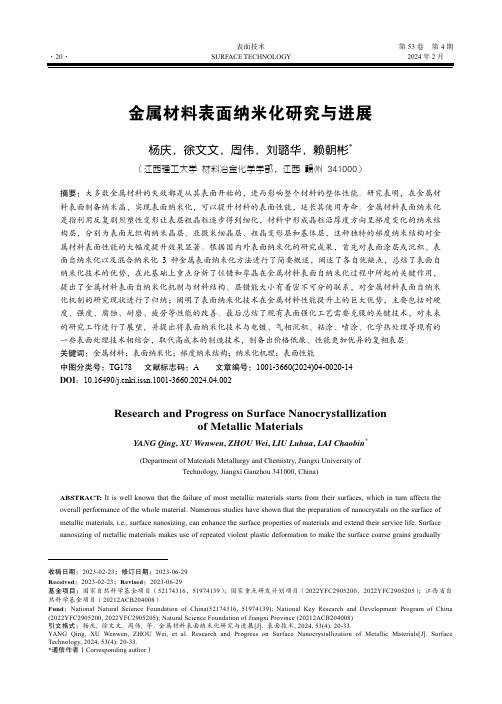
表面技术第53卷第4期金属材料表面纳米化研究与进展杨庆,徐文文,周伟,刘璐华,赖朝彬*(江西理工大学 材料冶金化学学部,江西 赣州 341000)摘要:大多数金属材料的失效都是从其表面开始的,进而影响整个材料的整体性能。
研究表明,在金属材料表面制备纳米晶,实现表面纳米化,可以提升材料的表面性能,延长其使用寿命。
金属材料表面纳米化是指利用反复剧烈塑性变形让表层粗晶粒逐步得到细化,材料中形成晶粒沿厚度方向呈梯度变化的纳米结构层,分别为表面无织构纳米晶层、亚微米细晶层、粗晶变形层和基体层,这种独特的梯度纳米结构对金属材料表面性能的大幅度提升效果显著。
根据国内外表面纳米化的研究成果,首先对表面涂层或沉积、表面自纳米化以及混合纳米化3种金属表面纳米化方法进行了简要概述,阐述了各自优缺点,总结了表面自纳米化技术的优势,在此基础上重点分析了位错和孪晶在金属材料表面自纳米化过程中所起的关键作用,提出了金属材料表面自纳米化机制与材料结构、层错能大小有着密不可分的联系,对金属材料表面自纳米化机制的研究现状进行了归纳;阐明了表面纳米化技术在金属材料性能提升上的巨大优势,主要包括对硬度、强度、腐蚀、耐磨、疲劳等性能的改善。
最后总结了现有表面强化工艺需要克服的关键技术,对未来的研究工作进行了展望,并提出将表面纳米化技术与电镀、气相沉积、粘涂、喷涂、化学热处理等现有的一些表面处理技术相结合,取代高成本的制造技术,制备出价格低廉、性能更加优异的复相表层。
关键词:金属材料;表面纳米化;梯度纳米结构;纳米化机理;表面性能中图分类号:TG178 文献标志码:A 文章编号:1001-3660(2024)04-0020-14DOI:10.16490/ki.issn.1001-3660.2024.04.002Research and Progress on Surface Nanocrystallizationof Metallic MaterialsYANG Qing, XU Wenwen, ZHOU Wei, LIU Luhua, LAI Chaobin*(Department of Materials Metallurgy and Chemistry, Jiangxi University ofTechnology, Jiangxi Ganzhou 341000, China)ABSTRACT: It is well known that the failure of most metallic materials starts from their surfaces, which in turn affects the overall performance of the whole material. Numerous studies have shown that the preparation of nanocrystals on the surface of metallic materials, i.e., surface nanosizing, can enhance the surface properties of materials and extend their service life. Surface nanosizing of metallic materials makes use of repeated violent plastic deformation to make the surface coarse grains gradually收稿日期:2023-02-23;修订日期:2023-06-29Received:2023-02-23;Revised:2023-06-29基金项目:国家自然科学基金项目(52174316,51974139);国家重点研发计划项目(2022YFC2905200,2022YFC2905205);江西省自然科学基金项目(20212ACB204008)Fund:National Natural Science Foundation of China(52174316, 51974139); National Key Research and Development Program of China (2022YFC2905200, 2022YFC2905205); Natural Science Foundation of Jiangxi Province (20212ACB204008)引文格式:杨庆, 徐文文, 周伟, 等. 金属材料表面纳米化研究与进展[J]. 表面技术, 2024, 53(4): 20-33.YANG Qing, XU Wenwen, ZHOU Wei, et al. Research and Progress on Surface Nanocrystallization of Metallic Materials[J]. Surface Technology, 2024, 53(4): 20-33.*通信作者(Corresponding author)第53卷第4期杨庆,等:金属材料表面纳米化研究与进展·21·refine to the nanometer level, forming nanostructured layers with gradient changes of grains along the thickness direction, including surface non-woven nanocrystalline layer, submicron fine crystal layer, coarse crystal deformation layer and matrix layer, and this unique gradient nanostructure is effective for the significant improvement of surface properties of metallic materials. The process technology and related applications of nanocrystalline layers on the surface of metallic materials in China and abroad are introduced, and the research progress of high-performance gradient nanostructured materials is discussed.Starting from the classification of the preparation process of gradient nanostructured materials and combining with the research results of surface nanosizing in China and abroad, a brief overview of three methods of metal surface nanosizing, namely, surface coating or deposition, surface self-nanosizing and hybrid nanosizing, was given, the advantages and disadvantages of each were discussed and the advantages of surface self-nanosizing technology were summarized. On the basis of this, the key role of dislocations and twins in the process of surface self-nanitrification of metallic materials was analyzed, and the mechanism of surface self-nanitrification of metallic materials was inextricably linked to the material structure and the size of layer dislocation energy, and the current research status of the mechanism of surface self-nanitrification of metallic materials was summarized. Finally, the key technologies required to be overcome in the existing surface strengthening process were summarized, and future research work was prospected. It was proposed to combine surface nanosizing technology with some existing surface treatment technologies such as electroplating, vapor deposition, tack coating, spraying, chemical heat treatment, etc., to replace the high-cost manufacturing technologies and prepare inexpensive complex-phase surface layers with more excellent performance.Techniques for the preparation of gradient nanostructured materials include surface coating or deposition, surface self-nanosizing, and hybrid surface nanosizing. Surface coating or deposition technology has the advantages of precise control of grain size and chemical composition, and relatively mature process optimization, etc. However, because the coating or deposition technology adds a cover layer on the material surface, the overall size of the material increases slightly, and there is a certain boundary between the coating and the material, and there will be defects in the specific input of production applications.In addition, the thickness of the gradient layer prepared by this technology is related to the deposition rate, which takes several hours to prepare a sample. The surface self-nanitrification technique, which generates intense plastic deformation on the surface of metal materials, has the advantages of simple operation, low cost and wide application, low investment in equipment and easy realization of unique advantages. The nanocrystalline layer prepared on the surface of metal materials with the surface self-nanitrification technique has a dense structure and no chemical composition difference from the substrate, and no surface defects such as pitting and pores, but the thickness of the gradient layers and nanolayers prepared by this technique as well as the surface quality of the material vary greatly depending on the process. Hybrid surface nanosizing is a combination of the first two techniques, in which a nanocrystalline layer is firstly prepared on the surface of a metallic material by surface nanosizing technology, and then a compound with a different composition from the base layer is formed on its surface by means of chemical treatment.To realize the modern industrial application of this new surface strengthening technology, it is still necessary to clarify the strengthening mechanism and formation kinetics of surface nanosizing technology as well as the effect of process parameters, microstructure, structure and properties on the nanosizing behavior of the material. For different nanosizing technologies, the precise numerical models for nanosizing technologies need to be established and improved, and the surface self-nanosizing equipment suitable for industrial scale production needs to be developed. In the future, surface nanosizing technology will be combined with some existing surface treatment technologies (e.g. electroplating, vapor deposition, adhesion coating, spraying, chemical heat treatment, etc.) to prepare a complex phase surface layer with more excellent performance, which is expected to achieve a greater comprehensive performance improvement of the surface layer of metal materials.KEY WORDS: metal material; surface nanocrystallization; gradient nanostructures; nanocrystallization mechanism; surface properties金属材料在基建工程、航空航天中扮演着重要角色,随着当今科学技术的高速发展,传统金属材料的局限性日趋明显,开发一种综合性能优异的金属材料迫在眉睫。
纳米材料与纳米技术研究进展

纳米材料与纳米技术研究进展近年来,随着科学技术的不断进步,纳米材料与纳米技术已成为热门话题,各国科学家也在纳米技术研究方面投入了大量的精力。
本文将介绍一些目前纳米材料与纳米技术研究的进展。
一、纳米材料研究进展1.金属纳米粒子金属纳米粒子是目前应用最广泛的纳米材料之一。
它的独特性质在医学、光电和材料科学等方面得到了广泛的应用。
近年来,科学家们发现,通过控制金属纳米粒子的形状和尺寸,可以进一步改善其性质。
例如,长轴为50纳米的椭球形金属纳米粒子比球形金属纳米粒子具有更好的光学特性。
因此,在未来的应用中,控制纳米粒子形状和尺寸将成为一项重要的研究方向。
2.化学合成纳米材料化学合成纳米材料是基于化学反应合成的新型材料。
其制备方法简单,成本低廉。
同时,科学家们也发现,通过控制反应条件,可以控制纳米材料的形状和尺寸。
因此,化学合成纳米材料发展前景非常广阔。
3.碳基纳米材料碳基纳米材料是一类以碳为主要成分的纳米材料。
它的制备方法多样,包括碳纳米管、石墨烯和类石墨烯材料。
在纳米材料领域,碳基纳米材料具有许多独特的性质,例如高强度、高导电性和高导热性。
因此,碳基纳米材料的应用范围非常广泛,包括能源存储、生物医学和电子器件等领域。
二、纳米技术研究进展1.纳米电子学纳米电子学是以纳米技术为基础的电子学。
在这个领域,科学家们研究如何使用纳米器件来替代传统电子器件,从而提高计算机的运行速度和存储容量。
同时,纳米电子学还可以应用于生物传感器、纳米机械和量子计算等领域。
2.纳米材料在能源存储中的应用随着可再生能源的发展,能源存储技术已变得越来越重要。
纳米材料在能量存储和转换中起着重要作用。
例如,纳米结构的锂离子电池具有更高的能量密度和更长的寿命,因此成为了研究热点之一。
同时,科学家们也在探索使用纳米结构的太阳能电池、燃料电池和超级电容器等能源存储装置。
3.纳米药物学纳米药物学是利用纳米技术制备药物纳米粒子,从而提高药物在体内的分布和靶向性。
纳米金粒子制备及应用研究进展

纳米金粒子制备及应用研究进展纳米技术在21 世纪将发挥极为重要的作用,是未来纳米器件、微型机器、分子计算机制造的最可能的途径之一。
纳米材料学作为纳米技术的重要组成部分也将会受到更广泛的重视。
科学家们利用纳米颗粒作为结构和功能单元,可以组装具有特殊功能如特殊敏感性和光、电、化学性能的纳米器件。
金属纳米颗粒由于其在量子物理,信息存储,复合材料等方面的潜在应用而引起了人们的注意。
其中,金纳米粒子由于其优异的导电性能,良好的化学稳定性及其独特的光学、催化特性而吸引了更多的目光。
这主要是因为:金是一种惰性元素,其化学稳定性良好;金和硫元素之间可以形成一种非常稳定的键合作用,这有利于在其表面组装带有各种官能团的单分子层。
由于纳米金粒子这些特有的化学性能以及独特的光、电性能,自上世纪80 年代至今,化学界对纳米金粒子的应用及其功能化研究方兴未艾。
本文综述了近年来纳米金粒子的制备及应用研究进展。
纳米金粒子的制备方法一.化学还原法制备法超细金粉制备原理:将金化合物的适当溶液通过化学还原而得到单质金粉.1.抗坏血酸为还原剂生产超细金粉工艺①王水溶金将黄金用去离子水冲洗,在置于稀硝酸中煮洗5~10min后,适当加热以启动反应,当反应较为平缓后,可再加入少量王水,直至大部分尽快获金粉溶解.反映结束时应保证体系中有少量未反应的黄金存在,即在投料时必须保证黄金的过量.②浓缩,赶硝将溶金液倾入另一烧杯中,用水洗净未反应的金块或金粉,转入下一循环使用。
洗液并入溶金液。
加热并在此过程中滴加浓盐酸以赶尽氮氧化物,过滤,滤液转入旋转蒸发皿进行浓缩结晶,然后配成适当浓度的水溶液。
③还原将抗坏血酸配成饱和溶液,在不断搅拌下,将氯金酸溶液滴加到抗坏血酸溶液中,滴加完毕后继续搅拌1h,静置沉降。
④清洗、干燥和筛分将上层清液倾出,用水和乙醇以倾析法清洗金粉。
所得金粉置于真空干燥。
冷却后,将金粉过筛分级,得到不同粒度的球形金粉末。
2.Na3C6H5O7 柠檬酸钠为还原剂制得纳米金颗粒粒径在15-20nm 之间Na3C6H5O7 为还原剂时,柠檬酸钠与氯金酸的摩尔比为1.5:1 时最佳;采用HAuCl4 溶液加入到加热的Na3C6H5O7 与聚乙烯吡咯烷酮(PVP)混合溶液Na3C6H5O7 溶液加入到室温的NaBH4 与PVP 混合溶液制得的纳米金溶胶的颗粒分散性好,粒径小且更均一。
纳米技术研究的现状和进展

纳米技术研究的现状和进展随着现代科技的不断发展,纳米技术正在成为人们关注的热点。
纳米技术是一种能够制造、处理和使用尺寸为1纳米(纳米是十亿分之一米)的材料和器件的技术。
它有着广泛的应用前景,可以用于制造微型芯片、纳米电子器件、纳米粉末等,也可以应用于生物医学、环境保护、食品工业等方面。
本文将介绍纳米技术的研究现状和进展。
一、纳米技术的发展历史纳米技术的发展可以追溯到1959年,当时美国科学家Richard Feynman在一次演讲中提出了“控制和操纵单个原子和分子”的概念,这就是纳米技术的雏形。
20世纪80年代,随着扫描电子显微镜和原子力显微镜的发明,科学家们开始能够观察和操纵单个原子和分子。
随着计算机和软件技术的进步,科学家们开始能够设计和模拟纳米材料的性质和行为。
在20世纪90年代,随着纳米技术的进一步发展,人们逐渐认识到纳米技术的重要性。
目前,纳米技术已经成为一个全球性的研究领域,涉及化学、物理、材料科学等多个学科。
二、纳米材料的制备和应用纳米材料是纳米技术的核心之一。
纳米材料具有尺寸小、比表面积大、性能优良等特点,可以应用于多个领域。
1.纳米金属材料纳米金属材料是一种具有特殊物理和化学性质的材料。
由于具有高比表面积、量子尺寸效应等特点,纳米金属材料在催化、储能等方面表现出优异的性能。
比如纳米银材料可以作为高效的抗菌材料,纳米铁材料可以应用于废水处理等。
2.纳米生物材料纳米生物材料是生物医学领域中应用的重要材料。
纳米生物材料可以用于治疗癌症、糖尿病等疾病,也可以用于疫苗制备、细胞成像等方面。
比如纳米载药系统可以将药物精确地送到病变部位,减少药物的毒副作用,纳米生物传感器可以快速、准确地检测病原体等物质。
3.纳米电子材料纳米电子材料在微电子和纳米电子器件中有着广泛的应用。
比如石墨烯、碳纳米管等纳米材料具有高导电性和优异的电学性能,可以应用于高频电子器件、传感器等方面。
三、纳米技术的发展现状和前景当前,纳米技术已经进入到一个快速发展的阶段。
纳米零价铁的应用研究进展

纳米零价铁的应用研究进展摘要:纳米零价铁结合了零价铁还原性强和纳米材料比表面积大的特点,可以通过不同机制降解各类环境污染物。
本文介绍了纳米零价铁在今后的研究重点和方向进行分析和展望。
关键词:纳米零价铁;重金属;污染物去除纳米零价铁可通过还原氧化、吸附沉淀等反应降解各类污染物,包括无机污染物(重金属、无机阴离子等)和有机污染物(卤代有机化合物、有机染料等),广泛应用于水处理和土壤修复方面。
1去除有毒重金属重金属主要包括汞、铬、铅、砷等难以被生物降解但却具有显著毒性的金属元素。
它们在水环境中的具有高度溶解性,有毒重金属可被活生物体吸收,一旦进入食物链,最终会进入人体并在器官中累积,如果摄入的有毒重金属超过允许的浓度,则可能导致严重的健康失调。
因此,有必要在将金属污染的废水排放到环境中之前对其进行处理。
Du等[1]引入人工腐殖酸(AHA)与nZVI协同作用,Pb2+与AHA-nZVI样品之间发生还原、络合和共沉淀反应,去除率高达99.2%。
当Hg2+,Cu2+,Cr3+等金属的E0远高于Fe的时,则还原作用为主导。
Akram等[2用生物炭基铁纳米复合材料(nZVI-BC)来去除水样中的砷,其去除机理主要包括表面特定的静电作用、氢键作用和氧化还原反应,其中氧化还原反应使剧毒As(III)转化为As(0)和As(V),As(III)和As(V)的最佳去除率分别为99.1%和96.1%。
2去除有机卤代物有机卤代物是水体环境中广泛存在的污染物之一,具有较强毒性和致癌性,并难以被生物所降解,等够长时间、长距离的迁移,在动植物身体和环境介质中均能检出,对环境危害较大。
与重金属不同的是,有机污染物可以改变官能团结构,使危害较大的污染物转换为危害较小的污染物。
氯代有机物在去除时,Ou等[3]发现加入短链有机酸(SCOAs)可以在酸性条件下促进nZVI降解五氯苯酚(PCP)。
草酸(OA)可以与PCP脱氯过程中产生的亚铁离子强烈地络合,并减少沉淀在nZVI表面的亚铁(氢)氧化物的形成。
纳米金属氧化物催化剂的研究及其应用

纳米金属氧化物催化剂的研究及其应用随着化学工业的快速发展,催化剂的需求与日俱增。
而纳米金属氧化物催化剂凭借其独特的性质,已成为催化领域的一大热点研究方向。
本文将就纳米金属氧化物催化剂的研究进展及其应用进行探讨。
一、纳米金属氧化物催化剂的研究进展纳米金属氧化物催化剂的研究起源于上世纪90年代中期,随后得到了长足的发展,具体而言,研究进展主要从以下三个方面展开。
1. 合成方法的研究纳米金属氧化物催化剂的性质与晶体结构密切相关,而合成方法能够决定其晶体结构、粒径、分散度等特征。
传统的合成方法包括水热法、溶胶-凝胶法、共沉淀法等,这些方法能够制备出高稳定性、纯度高的纳米金属氧化物催化剂。
而近年来,还涌现了很多新的合成方法,比如溶液相法、可控大分子刻蚀法、模板法等,这些方法不仅能够控制催化剂的尺寸、形态及晶面等性质,还具有绿色合成的特点,能够有效地减少对环境的影响。
2. 催化性能的研究纳米金属氧化物催化剂的催化性能与其纳米尺度效应有关,具体而言,主要表现在以下几个方面:一是表面积大,活性位点多,因此催化活性较高;二是电子结构易于调控,催化剂的选择性较好;三是具有优异的吸附性能,催化剂的稳定性较高。
3. 应用研究纳米金属氧化物催化剂的应用范围广泛,涉及有机合成、环境保护、能源等领域。
在有机合成领域,纳米金属氧化物催化剂已经成为合成精细化合物和药物的重要工具,例如在羰基化、氢化和氧化反应中,纳米金属氧化物催化剂均可以发挥重要的催化作用;在环境保护领域,纳米金属氧化物催化剂可以用于VOCs的去除和重金属离子的吸附等。
此外,在能源领域,纳米金属氧化物催化剂也有广泛的应用,例如用于柴油机废气净化、太阳能电池材料的合成等。
二、纳米金属氧化物催化剂的应用前景综上所述,纳米金属氧化物催化剂具有许多独特的性质和广泛的应用前景,尤其是在环保和能源方面有着独特的优势。
除了已经应用于生产中的有机合成、废气净化、太阳能电池等领域,纳米金属氧化物催化剂还有许多未被充分开发的应用领域,例如用于水催化氧化CO、NOx污染物等气体污染的去除。
纳米金属材料的制备与应用研究
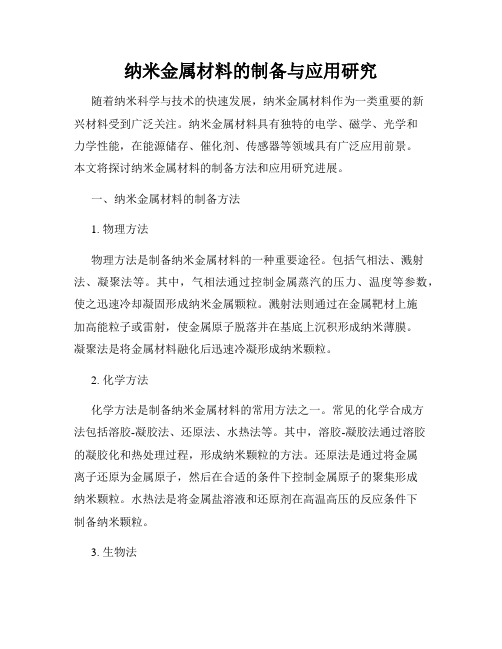
纳米金属材料的制备与应用研究随着纳米科学与技术的快速发展,纳米金属材料作为一类重要的新兴材料受到广泛关注。
纳米金属材料具有独特的电学、磁学、光学和力学性能,在能源储存、催化剂、传感器等领域具有广泛应用前景。
本文将探讨纳米金属材料的制备方法和应用研究进展。
一、纳米金属材料的制备方法1. 物理方法物理方法是制备纳米金属材料的一种重要途径。
包括气相法、溅射法、凝聚法等。
其中,气相法通过控制金属蒸汽的压力、温度等参数,使之迅速冷却凝固形成纳米金属颗粒。
溅射法则通过在金属靶材上施加高能粒子或雷射,使金属原子脱落并在基底上沉积形成纳米薄膜。
凝聚法是将金属材料融化后迅速冷凝形成纳米颗粒。
2. 化学方法化学方法是制备纳米金属材料的常用方法之一。
常见的化学合成方法包括溶胶-凝胶法、还原法、水热法等。
其中,溶胶-凝胶法通过溶胶的凝胶化和热处理过程,形成纳米颗粒的方法。
还原法是通过将金属离子还原为金属原子,然后在合适的条件下控制金属原子的聚集形成纳米颗粒。
水热法是将金属盐溶液和还原剂在高温高压的反应条件下制备纳米颗粒。
3. 生物法生物法是利用生物体合成纳米金属材料的方法。
具体来说,通过使用微生物、植物或其他生物体代谢产物作为还原剂,与金属盐反应生成纳米颗粒。
生物法具有环境友好、操作简单和低成本等优点。
二、纳米金属材料的应用研究1. 能源储存纳米金属材料在能源储存领域具有广泛应用前景。
例如,纳米金属材料常用于制备高性能锂离子电池和超级电容器。
纳米尺度的金属颗粒具有较大比表面积和较短的离子和电子传输路径,有利于提高电池和超级电容器的性能。
2. 催化剂纳米金属材料在催化剂领域有重要的应用。
纳米金属颗粒具有较高的比表面积和丰富的表面活性位点,可以提高催化反应的速率和选择性。
特别是在有机合成和环境保护等领域,纳米金属催化剂表现出了独特的催化活性。
3. 传感器纳米金属材料在传感器领域具有广泛应用前景。
通过制备具有特殊形貌和表面结构的纳米金属材料,可以提高传感器对目标分子的检测灵敏度和选择性。
纳米金的药用研究进展

纳米金的药用研究进展引言纳米金是一种由金原子组成的纳米级粒子,具有独特的物理化学性质,如高电子密度、较强的生物相容性和良好的稳定性等。
近年来,纳米金因其潜在的药用价值而备受,成为药物研发领域的新热点。
本文将探讨纳米金的药用研究进展,介绍纳米金的制备方法、质量控制、药效评估及其在药物传输载体和治疗药物生产原料等方面的应用前景。
研究现状随着纳米金制备技术的不断发展,越来越多的研究成果表明纳米金在药物传输、药物生产和其他生物医学领域具有广泛的应用前景。
目前,许多科研团队正在进行纳米金药用领域的研究,并取得了一系列令人鼓舞的成果。
然而,纳米金的药用研究仍处于初级阶段,仍存在许多挑战和问题需要解决。
研究方法纳米金的制备方法主要包括物理法、化学法和生物法。
其中,化学法是最常用的制备方法,通过特定的化学反应将金离子还原为金原子并组装成纳米粒子。
质量控制方面,纳米金的尺寸和形态是影响其药效的主要因素,因此需要建立严格的质量控制标准,确保制备的纳米金符合药用要求。
药效评估是纳米金药用研究的重要组成部分,通常采用细胞实验和动物实验等方法对纳米金的药物效果进行评估。
研究进展纳米金在药用领域的应用前景十分广泛。
首先,纳米金可以作为药物传输载体,将药物分子精准地输送到病变部位,提高药物的疗效并降低副作用。
其次,纳米金可以作为治疗药物的生产原料,直接对疾病产生治疗作用。
例如,纳米金可以通过抑制炎症反应、促进细胞再生等途径治疗创伤和烧伤。
此外,纳米金还可以用于药物研发中的荧光标记和成像技术,有助于药物设计和优化。
纳米金的药用研究取得了一定的成果,但仍存在许多不足和挑战。
未来研究方向包括:1)深入研究纳米金的生物效应和毒性,以评估其长期使用安全性和潜在风险;2)探索更高效、环保的纳米金制备方法,以满足大规模生产需求;3)优化纳米金的表面修饰和功能化,以提高其在生物体内的稳定性和靶向性;4)将纳米金与其他治疗手段(如光疗、热疗等)相结合,以提高疾病的治疗效果;5)推动纳米金药物的临床试验和转化研究,以加快其从实验室走向市场的进程。
纳米金属功能材料研究进展

图 6 纳米 晶C 块体材 料 的低 温 比热容 u
针 对 激 光 惯 性 约 束 聚 变 中 双 壳 层 点火 靶 靶 型 结构 需 求 , 如 何 制 备 出适 合 需 求 的超 低 密 度 泡 沫
金 属 材 料 已成 为 该 领 域 的一 个 难 点 。 以聚 氨 酯 为 模 版 ,采 用 电化 学 沉 积 方 法 制 备 出低 密 度 高 孔 隙
▲ 4 j3 O@ 副 罗1 i2 86 a. 研c 1o nm 6 g 江 究 — s h 2 员 4 a 山 8 n l u 2 o
纳米 金属 功 能材 料研 究 进展
纳 米 金 属 材 料 是 一 类 重 要 的激 光 惯 性 约 束 聚 变 和 强 辐 射 源 靶 材 料 。通 过 靶 材 料 微 观 结 构 的 调 控 ,将 其 特 征 尺 寸 降低 到 纳 米 量 级 , 已成 为 该研 究领 域 的一 种 新 型 研 究 手 段 。针 对 目前 I F 和 强 C 辐 射 源 物 理研 究 的 目标 和 需 求 ,本 单位 在 纳 米 金 属 功 能材 料 研 究 方 向 开 展 了一 些 研 究 工 作 ,取 得 了初 步 的研 究成 果 ,主 要 有 :
以 自悬浮 定 向流 技 术 为基 础 ,研 发 出 NMP —I型纳 米 金 属 粉 末 制 备装 置 ,其 外 形 图如 图 1 ,并
制 备 出纯 金属 、金 属 问化合 物等 相 关 纳 米 粉 末 ,其 T M 照 片 如 图 2所 示 。 该 设备 能 够 实 现连 续 批 E 量 生 产 ,工 艺稳 定 , 体 积 相 对 较 小 。纳 米 粉 末 纯 度 高 ,和 原材 料 一 致 。纳 米 粉 末 呈 近 球 形 ,松 装 密度 2 5 %~ %;纳 米 粉 末 粒 径 大 小 在 3 ~ 0 m 可 自 由调 节 ,粒径 分 布较 窄 ;纳 米粉 末 取样 可 在惰 0 2 0n
纳米材料的性能及其应用研究进展
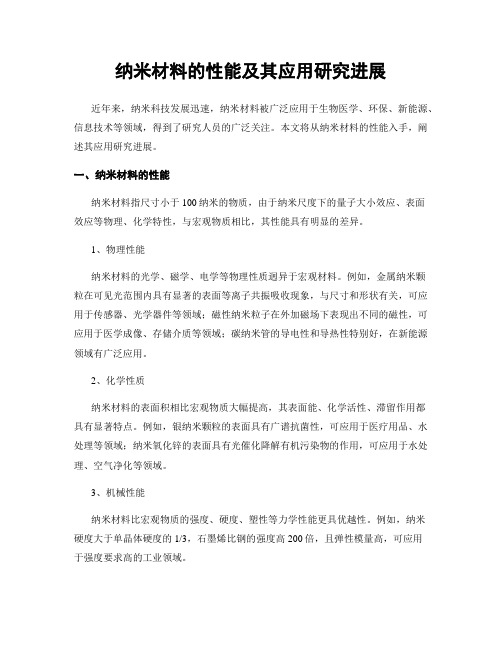
纳米材料的性能及其应用研究进展近年来,纳米科技发展迅速,纳米材料被广泛应用于生物医学、环保、新能源、信息技术等领域,得到了研究人员的广泛关注。
本文将从纳米材料的性能入手,阐述其应用研究进展。
一、纳米材料的性能纳米材料指尺寸小于100纳米的物质,由于纳米尺度下的量子大小效应、表面效应等物理、化学特性,与宏观物质相比,其性能具有明显的差异。
1、物理性能纳米材料的光学、磁学、电学等物理性质迥异于宏观材料。
例如,金属纳米颗粒在可见光范围内具有显著的表面等离子共振吸收现象,与尺寸和形状有关,可应用于传感器、光学器件等领域;磁性纳米粒子在外加磁场下表现出不同的磁性,可应用于医学成像、存储介质等领域;碳纳米管的导电性和导热性特别好,在新能源领域有广泛应用。
2、化学性质纳米材料的表面积相比宏观物质大幅提高,其表面能、化学活性、滞留作用都具有显著特点。
例如,银纳米颗粒的表面具有广谱抗菌性,可应用于医疗用品、水处理等领域;纳米氧化锌的表面具有光催化降解有机污染物的作用,可应用于水处理、空气净化等领域。
3、机械性能纳米材料比宏观物质的强度、硬度、塑性等力学性能更具优越性。
例如,纳米硬度大于单晶体硬度的1/3,石墨烯比钢的强度高200倍,且弹性模量高,可应用于强度要求高的工业领域。
二、纳米材料的应用研究进展1、生物医学领域纳米材料在生物医学领域有广泛应用,包括药物送递、分子诊断、组织工程、生物成像、抗菌等方面。
例如,通过化学修饰,纳米材料可选择性地靶向癌细胞,并释放药物;同时,纳米颗粒的表面还可与生物分子相互作用,形成生物传感器,应用于分子诊断和成像。
2、环保领域纳米材料在环保领域的应用包括空气净化、水处理和废物处理等方面。
例如,纳米TiO2、纳米铁等材料具有光催化降解作用,可应用于水处理和空气净化;纳米材料与污染物结合后可通过热解、燃烧等方式进行处理。
3、新能源领域纳米材料在新能源领域的应用主要集中在太阳能电池、储能材料和催化剂等方面。
铂、钯基纳米材料的合成及催化性能研究进展

处于纳米尺度或由其作为基本单元构成的金属材料。
基于维数的不同,可将其大体划分为零维、一维、二维纳米材料。
纳米材料的形状丰富多样,可以为球形,也可以呈柱状。
基于原子分布特性的不同,可将其大体划分为结晶、非晶和准结晶;基于相结构的不同,可将其简单地分为两类:一类是单相,另一类则是多相。
目前,金属纳米材料的合成方法主要包括两种:一种是物理合成法,比如真空冷凝等,由于此方法需使用多种装置,并且操作繁琐、工作量大,使其在工业领域并未得到大力推广和积极应用。
另一种是化学方法,是从下到上,并控制纳米级材料的生长过程。
近年来,化学合成方法取得了长足进展,尤其是液相合成方法,变得越来越严谨完善,凭借着此类方法,人们已推出了各种不同的金属纳米材料。
目前,在工业领域,应用比较广泛的几种液相合成方法如下:(1)模板法。
模板法可大体分为两类:一类是硬模板法,另一类则是软模板法。
在现实中,很多材料都能够被用于制作模板,比如氧化铝、沸石、Te 纳米线、Ag 纳米线、等,它们比较易溶混合表面活性剂液晶或表面活性剂模板等。
通过模板法制备的纳米材料相对均匀,但是在后期往往要通过酸等相关物质溶蚀硬模板,由于此原因,此方法并未得到业内人士的认可和支持,其应用严重受限。
(2)溶剂热法。
当前,水热法应用比较广泛,溶剂热法也日益受到更多业内人士的关注和研究。
若将水热反应归类为溶剂热法,则更加可行。
此反应一般会选取特定的溶剂(比如水)对金属前体进行有效溶解。
若表中存在活性剂等物质,将随着溶液一并进入反应罐内,同时,在高温溶液的汽化压力作用下制成纳米材料。
概括来讲,此方法操作容易,将各种纳米材料全部1 催化反应人们使用催化反应的历史由来已久,但是催化的概念出现于1835年,其提出者为瑞典著名化学家贝采尼乌斯(Berzelius)。
在发生化学反应的过程中,原始分子的化学键会汲取大量的能力,产生新的化学键,在此过程中,会出现能量转移的情况。
催化反应过程中,加入此物质能够明显减少反应时消耗的能量,从而使得能垒明显减弱,促其更快速、更容易地发生反应。
纳米多孔金属材料的制备与性能研究

纳米多孔金属材料的制备与性能研究随着科学技术的不断发展,纳米材料在各个领域展现出了巨大的潜力。
其中,纳米多孔金属材料作为一种重要的纳米材料,在催化、能源储存、传感器等领域具有广泛的应用前景。
本文将重点探讨纳米多孔金属材料的制备方法以及其在各个领域中的性能研究进展。
一、纳米多孔金属材料的制备方法1. 溶剂热法溶剂热法是一种常用的纳米多孔金属材料制备方法。
一般来说,该方法需要采用一种有机溶剂和金属盐进行加热反应。
在反应过程中,溶剂的热解释放出的气体会形成孔洞结构。
通过控制反应条件中溶剂的种类、浓度和反应温度等因素,可以得到不同孔径和孔壁的纳米多孔金属材料。
2. 模板法模板法是一种制备纳米多孔金属材料的常见方法。
该方法使用一种具有特殊结构的模板作为模板。
首先,将金属溶液浸渍在模板上,然后进行热处理,使金属溶液沉积在模板的孔洞内。
最后,通过模板的去除,纳米多孔金属材料得以制备。
模板法制备的纳米多孔金属材料具有高孔隙度和可控的孔径尺寸,适用于催化剂和储能材料的制备。
3. 电沉积法电沉积法是一种通过电化学反应在电极上制备纳米多孔金属材料的方法。
通常,该方法将金属盐溶液作为电解液,将电极作为阳极或阴极。
通过调节电化学反应条件,如电位、电流密度和反应时间等,可以控制纳米多孔金属材料的形貌和孔隙结构。
电沉积法制备的纳米多孔金属材料具有高比表面积和良好的电化学性能,在储能和传感器领域具有较大的应用潜力。
二、纳米多孔金属材料的性能研究1. 催化性能纳米多孔金属材料在催化领域中展现出了重要的应用价值。
首先,由于其高比表面积和多孔结构,纳米多孔金属材料具有较高的反应活性。
其次,纳米多孔金属材料具有可调控的孔径尺寸和孔隙结构,可以提供更多的活性位点,有利于催化反应的进行。
最后,纳米多孔金属材料还具有较好的传质能力和稳定性,能够提高催化反应的效率和持久性。
2. 能源储存性能在能源储存领域,纳米多孔金属材料也显示出了良好的性能。
纳米材料在催化剂中的应用研究进展

纳米材料在催化剂中的应用研究进展随着化学和材料科学的不断发展,纳米材料作为一种新型材料,正逐渐被广泛应用于各个领域,其中催化剂领域是其重要应用之一。
纳米材料具有高比表面积、优异的化学和物理性质,这使它们成为催化剂领域的很好选择。
本文将介绍纳米材料在催化剂中的应用研究进展。
一、纳米材料在催化剂中的优势纳米材料作为一种新型材料,具有很多优势。
首先,它们具有高比表面积,这是由于其较小的尺寸和高表面积-体积比率导致的。
这种高比表面积使纳米材料能够提供更多的活性位点,这是催化反应所需要的。
其次,纳米材料具有优异的物理和化学性质。
这些性质可以被控制和调控,以实现所需的催化反应。
此外,纳米材料还可通过控制粒子大小、形态和晶体结构等参数,实现催化反应选择性和反应速率调控等目的。
二、纳米材料在不同催化剂领域的应用1.金属纳米材料在催化剂领域的应用金属纳米材料具有高比表面积和独特的电子性质,从而成为催化剂领域的研究热点之一。
例如,纳米铜、纳米铁等金属材料在催化反应中都具有优异的催化性能。
纳米铜在醇类氧化反应中表现出高催化活性和选择性。
纳米铁在有机污染物再生中也有广泛的应用。
此外,金属纳米材料还可制备成对氢和氧的催化剂来用于燃料电池等领域。
2.纳米氧化物应用于催化剂领域纳米氧化物具有高比表面积和特殊的表面活性位点,可用于氧化反应、酯化反应等催化反应。
例如,二氧化钛、氧化锌、氧化铝等氧化物催化剂都有着广泛的应用。
其中,二氧化钛纳米材料在污染物的催化降解、环境净化等领域的研究也得到了广泛关注。
3.法国叔叔纳米材料在催化剂领域的应用法国叔叔纳米材料由于高比表面积、强大蓄电能力和天然的催化性能等优势,可以用于电催化剂和能源转换等应用。
如,有研究表明,法国叔叔纳米线可以优化锂离子电池的储能性能,并通过制备铂包覆的法国叔叔纳米线来制备白金基的电催化剂,用于燃料电池的氧还原反应。
三、纳米材料在催化剂领域的未来发展随着催化科学和技术的不断发展,在催化剂领域中,纳米材料将受到更广泛的应用。
多孔负载型纳米金属催化剂制备研究进展
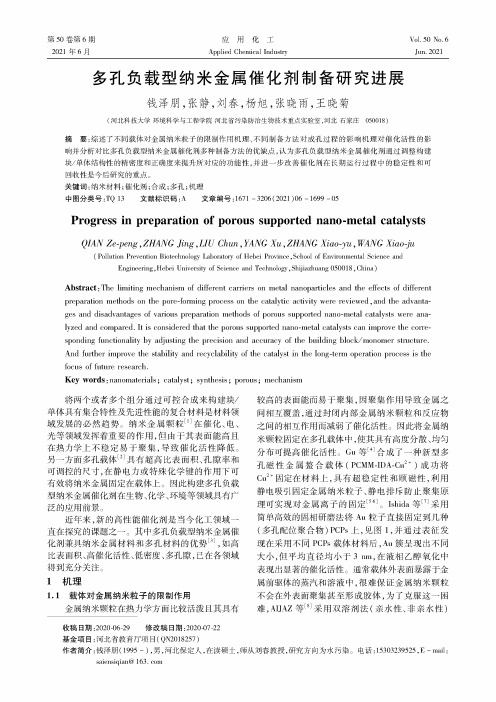
(4合成的纳米笼具有丰富的孔隙,在提供丰富的
中心同
& 的 ;( 2) 催化 中
种氧化 存在协同作用。TUn等[-2]以Fe2O3纳米
成、尺寸等分布具
的
,其冷冻干燥 粒子
位蚀刻提供铁源且作 板构建分层多
的 、温度对材料的形成
关系,是一种
e—: 作 备材 的方法,但冻干 D[Yv
,柠檬酸作 源
,采用原位模板刻
•
现象,
发生相变将材
分冻结成固
‘, : K %
c
UY
•,
从 到多孔材料的一种技术。
多篇文
了冷冻干燥法制备多孔金属
催化剂。Lb3]采用类 PV冻干燥的方式,构建
了 c 的多 金属 a 的金属 T( L
述了冷冻干燥 中金属 Ah 3。
催化
成的
图3冻干法制备催化剂可能形成机理
Fig. 3 Possible formation mechanism of catalyst popao/ by foezc-do/g method
存在从 备多孔材料8。 不同催化 备方法
备条件对应不同成孔
原理,其成孔的均 、富余性、大 心在 中的分 对催化
以及 中 生作用。
将各种方法的优势
的潜
。
在催化
备方面具有良好
2多孔负载型金属催化剂的制备方法
多孔纳米金属复合物催化 成方法有很4,
的可以分为自
的合成方法和自
的合
成方法。自
的合成方法多 理法,包括高
Pragress io preyaration of poraus sppported nano-metai chtalyset
QIAN Ze-qeeg, ZHANG Jing ,LIU Chun, YANG Xu, ZHANG Xiao-qu, WANG Xiao-ju
纳米金属材料的毒理学研究进展

影 响的安全 隐患 。现对 近期 有关纳米 金属 材料毒 性作
用 的研究作 一综述 。
到 21 , 05年 纳米 技术创 造 的社 会价 值将超 过 1万亿 美
元 。纳 米材 料 是指 至少 一维 空 间 的 粒径 ≤10 n 0 m 的材料 , 纳米金 属是 利用 纳 米 技术 制 造 的具 有 纳 米 级
ห้องสมุดไป่ตู้
金属 材料 可 引起 细胞线 粒体功 能损 害 、 渗 透性 增 加及 细胞 形 态的 凋亡 样 变化 , 膜 并影 响机 体 多个 器 官的 功 能 ; 出应加 强纳 米金属材 料毒 理 学的研 究 , 立评 价 纳 米产 品生 物安 全性 的标 准 方 法及评 价 体 系, 指 建 为纳 米
东t学v‘ci2,;1一1 J ht e学 ;。F3 )16 S大U嚣dE) 1e。 :。 oe n 医 版 … … (。 … 南a学MSd b 1 5 usi ( i 1 5 ‘
・
・1 1・ 5
综 述 ・
纳 米 金 属 材 料 的毒 理 学 研 究 进 展
张 姗 姗 , 玉英 薛
来, 随着 纳米技 术 的发 展和 纳米材 料 的广 泛应 用 , 对 它 环境 以及 生物 体可能 产生 的影响越 来越 受到人 们 的关
注 。2 0 0 4年 7月 , 国皇 家学 会发 布 了 “ 英 纳米 科 学 与 纳米技术 : 机遇 与不 确定 因素 ” 的报 告 , 评估 了纳 米 技
术对健康 和 环 境 的 影 响 E 。20 3 05年 5月 , 主 题 为 ] 在 “ 纳米技术 的安 全承诺 : 境 法能 否胜 任 ? 的会议 上 , 环 ” 专家们讨 论 了纳米技 术 对环 境 和 人类 健 康 的影 响 , 认
纳米金属材料发展

纳米金属材料可用于制造生物相容性材料 ,如生物支架和药物载体等,为生物医学 领域提供了新的发展方向。
02
纳米金属材料的研究进展
纳米金属材料的物理性能
01
02
03
表面效应
纳米金属材料的表面原子 数增多,导致表面能增加 ,对材料的物理性能产生 显著影响。
小尺寸效应
纳米金属材料的小尺寸效 应导致材料具有高熔点、 高强度、高韧性和良好的 导电性能。
01
随着计算能力的提升,通过计算设计具有优异性能的
纳米金属材料将成为可能。
绿色合成
02 发展绿色、可持续的纳米金属材料合成方法将有助于
推动纳米金属材料的应用。
多学科交叉
03
纳米金属材料的发展将促进多学科交叉,包括物理、
化学、生物学、医学、环境科学等。
04
纳米金属材料的挑战与机 遇
纳米金属材料的稳定性与安全性问题
纳米金属材料产业发展趋势
未来,纳米金属材料产业将朝着多元化、智能化、绿色化方向发展。其中,多元化是指纳米金属材料 的应用领域将不断扩大;智能化是指纳米金属材料的制备和应用将更加智能化;绿色化是指纳米金属 材料的制备和应用将更加环保。
纳米金属材料的政策建议与对策
加强政策引导
政府应加强对纳米金属材料研究 的政策引导,加大对纳米金属材 料产业的扶持力度,推动纳米金 属材料产业的发展。
量子尺寸效应
对于纳米金属材料,量子 尺寸效应导致材料的能级 间隔增大,对材料的物理 性能产生影响。
纳米金属材料的化学性能
高的化学活性
纳米金属材料具有高的化 学活性,能够作为催化剂 和催化剂载体使用。
易氧化
纳米金属材料易于氧化, 需要采取保护措施以防止 氧化。
- 1、下载文档前请自行甄别文档内容的完整性,平台不提供额外的编辑、内容补充、找答案等附加服务。
- 2、"仅部分预览"的文档,不可在线预览部分如存在完整性等问题,可反馈申请退款(可完整预览的文档不适用该条件!)。
- 3、如文档侵犯您的权益,请联系客服反馈,我们会尽快为您处理(人工客服工作时间:9:00-18:30)。
背景介绍
纳米金属结构材料 的特性 界面缺陷模型
纳米金属颗 粒的特性 表面效应
体积效应
量子尺寸效应 宏观量子隧道效应
纳米金属材 料的特性
类气态模型
界面可变模型
纳米金属的制备方法
快速凝固法 非晶晶化法
惰性气体蒸发、原位加压制备法
强烈塑性变形法
电解沉积技术
高能球磨法(机械合金化)
Converting homogeneous to heterogeneous in electrophilic catalysis using monodisperse metal nanoparticles
Figure 1 | Depiction of the two nanoparticle synthesis techniques used and the initial reactivity results for electrophilic catalysis
Materials Research Bulletin 45 (2010) 558–563
Ba0.5Sr0.5Co0.8Fe0.2O3 nanopowders prepared by glycine–nitrate process for solid oxide fuel cell cathode
Flowchart for glycine–nitrate synthesis of BSCF powders.
7,Nakamura, I., Sato, Y. & Terada, M. Platinum-catalyzed dehydroalkoxylationcyclization cascade via N–O bond cleavage. J. Am. Chem. Soc. 131,4198–4199 (2009).
参考文献
1, Knecht, M. R. et al. Synthesis and characterization of Pt dendrimer-encapsulated nanoparticles: effect of the template on nanoparticle formation. Chem. Mater.20, 5218– 5228 (2008). 2, Lee, I., Delbecq, F., Morales, R., Albiter, M. A. & Zaera, F. Tuning selectivity in catalysis by controlling particle shape. Nature Mater. 8, 132–138 (2009). 3, Mahmoud, M. A., Tabor, C. E., El-Sayed, M. A., Ding, Y. & Wang, Z. L. A new catalytically active colloidal platinum nanocatalyst: the multiarmed nanostarsingle crystal. J. Am. Chem. Soc. 130, 4590–4591 (2008). 4,Bhattacharjee, S., Dotzauer, D. M. & Bruening, M. L. Selectivity as a functiononanoparticle size in the catalytic hydrogenation of unsaturated alcohols. J. Am. Chem. Soc. 131, 3601–3610 (2009). 5,Lee, H. et al. Morphological control of catalytically active platinum nanocrystals.Angew. Chem. Int. Ed. 45, 7824–7828 (2006).
6,Delbecq, F. & Zaera, F. Origin of the selectivity for trans-to-cis isomerizationin 2butene on pt(111) single crystal surfaces. J. Am. Chem. Soc. 130,14924–14925 (2008).
Contents
1 2 3 4
背景介绍
纳米金属材料的新进展 纳米金属材料的应用 总结与展望
纳米金属材料的应用
微孔材料 催化材料
活化烧结材料
助燃剂
高性能磁性材料
波能吸收材料
Contents
1 2 3 4
背景介绍
纳米金属材料的新进展 纳米金属材料的应用 总结与展望
总结与展望 纳米金属材料是传统金属材料超细化后 出现的新材料。它具有宏观物体所没有的 新效应, 因而开拓新的应用领域。利用纳米 金属材料特殊的特性与效应, 将开拓出前所 未有的和不可替代的新的材料世界的领域
nature materials VOL 7 APRIL 2008
Figure 2 TEM images. a,b, Ru@Pt (a) and PtRu alloy (b) nanoparticles. The insets show HRTEM images (top), and particle size histograms (bottom). Histograms are made by counting 200 particles. Each bar represents 0.5 nm diameter, and dashed lines the average sizes, which are 4.1 nm and 4.4 nm, respectively.
Journal of Alloys and Compounds 453 (2008) 418–422
SEM photographs of as-prepared powders. G/n molar ratio is (a) 0.28, (b) 0.56, and (c) 0.84.
Ru–Pt core–shell nanoparticles for preferential oxidation of carbon monoxide in hydrogen
LOGO
ห้องสมุดไป่ตู้
Microstructure control on thermoelectric properties of Ca0.96Sm0.04MnO3 synthesised by co-precipitation technique
(a) Typical low magnification image of aggregated particles. (b) Shape and size distribution of dispersed nanoparticles. Inset: selected area electron diffraction pattern of nanoparticles with typical rings of diffraction spots. (c) SAED pattern with calculated ED ring patterns superposed and labeled with (h, k, l) indices cell parameters a = 5.285A˚ , b = 7.480A˚ , c = 5.272A˚ (Pnma space group).
XRD pattern of Ca0.96Sm0.04MnO3 powders calcined for 6 h at (a) 873 K (b)973 K and (c) 1073 K.
Temperature dependence of S (a) and ZT (b) two k (a) and r (b) of Micrographs of of two samples of Ca0.96Sm0.04MnO3, Ca0.96Sm0.04MnO3 bar sintered samples of Ca0.96Sm0.04MnO3, CP1623 (black squares)(black squares) and CP1623 and NP1373 (red circles). at (a) 1373 K and (b) 1623 K.
纳米金属研究进展
LOGO
Contents
1 2 3 4
背景介绍
纳米金属材料的新进展 纳米金属材料的应用 总结与展望
背景介绍 “纳米金属”( nanometal) 利用纳米技术制造的金属材料,具有纳米 级尺寸的组织结构,在其组织中也包含着 纳米颗粒杂质。
纳米金属材料
纳米金 属粉末
纳米金属 结构材料
